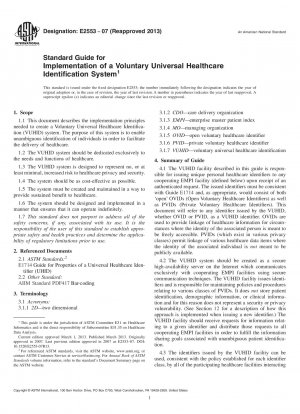ASTM E2553-07(2013)
Standard Guide for Implementation of a Voluntary Universal Healthcare Identification System
- Standard No.
- ASTM E2553-07(2013)
- Release Date
- 2007
- Published By
- American Society for Testing and Materials (ASTM)
- Latest
- ASTM E2553-07(2013)
- Scope
5.1 This standard describes a proposal to provide unambiguous personal identification for any patient who requests it. In today’s world of specialized healthcare and mobile patients it is typical for clinical information on a single patient to reside in a variety of locations, some using manual data storage techniques, but an increasing number using electronic means. In order for a clinician to provide safe and appropriate clinical care in this environment it is necessary to be able to aggregate appropriate clinical information on a specific patient in order to gain an accurate and comprehensive picture of that patient’s clinical situation. This implies that all information relating to each patient should be identified in a unique manner to facilitate the process of accurately aggregating appropriate information.
5.2 The converse of the need for data aggregation is the patient’s need to protect the privacy of their information. Unless patients are confident that they can avoid inappropriate sharing of clinical information they will not readily share that information with caregivers. Thus, the same system that supports unambiguous linkage of all information concerning a patient must also play a role in protecting the privacy of that information.
5.3 The proposed patient identification system must be able to avoid or overcome the numerous objections that have prevented implementation of a universal patient identification system in the past including issues related to:
5.3.1 Technology—The proposed system must be technically feasible in a manner that promotes scalability, availability, and ease of implementation.
5.3.2 Integration with Existing Systems—To the maximum extent possible the proposed identification system should work seamlessly with existing information systems.
5.3.3 Cost-effectiveness—The proposed system should balance the costs and benefits required to implement a fully functional voluntary universal healthcare identification system.
5.3.4 Political Feasibility—Because many different constituencies have a vested interest in a universal patient identification system, it has been a significant challenge to gain consensus on how to implement such a system.
5.4 Experience has shown that a healthcare identification system will only be feasible if it is dedicated exclusively to the needs of healthcare. It is only in this focused environment that it has been possible to create a consistent, feasible, functional, and effective design for such a system.
1.1 This document describes the implementation principles needed to create a Volun......
ASTM E2553-07(2013) Referenced Document
- ASTM E1714 Standard Guide for Properties of a Universal Healthcare Identifier (UHID)
ASTM E2553-07(2013) history
- 2007 ASTM E2553-07(2013) Standard Guide for Implementation of a Voluntary Universal Healthcare Identification System
- 2007 ASTM E2553-07 Standard Guide for Implementation of a Voluntary Universal Healthcare Identification System

Copyright ©2024 All Rights Reserved